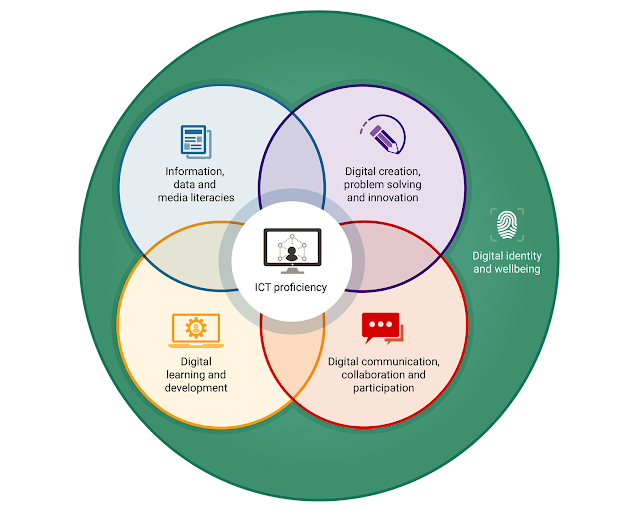I'm writing this blog post as part of the Digital Literacies for Online Learning course, where we're asked to explore different definitions of digital literacies and construct a personal definition based on our reading.
It's interesting to note that originally the term was used in the singular - 'digital literacy' - but, as explained in AdvanceHE's (n.d.) handy history of the term, the increasing complexity of the digital world and the skills needed to navigate it shifted usage to the plural.
I find it helpful to start with a short definition of digital literacies which sets the boundaries of what we are talking about: digital literacies are "those capabilities which support living, learning and working in a digital society" (Jisc, n.d.). This definition indicates how, for many of us, the digital environment now impacts on most aspects of our lives. It also emphasises that digitalisation needs to be understood as a social phenomenon. Digital tools have changed our social behaviours, created new cultural norms and generated whole new communities. Therefore digital literacies need to encompass new social capabilities as well as technical ones.
We can now drill down into the more detailed definitions of digital literacies. As a starting point, I like to refer to Jisc's (2019) digital capability framework diagram:
 |
| Building digital capabilities: the six elements defined, © Jisc, licensed under a CC BY-NC-SA licence |
I find the diagram helpful in showing that ICT (information and communication technology) proficiency - or technical digital skills - is an essential core of digital capabilities, but that digital literacies go beyond that, into four different domains of activity. Surrounding all of these is the need for a safe and responsible approach to digital identity and wellbeing (one’s own and others’), which is potentially at risk in any of the other domains. The framework is described in more detail in Jisc's definitions document (2019).
Technical digital skills are sometimes described as being separate from digital literacies (for example Bali (2016)), but, like Jisc, I see them instead as a subset of digital literacies, as they encompass all the essential practical skills and knowledge needed for using digital hardware (computers, smartphones etc.) and software (apps, search engines etc.). As well as mechanical skills such as typing and using a touchscreen, they include visual literacy to recognise the symbols which support navigation and interaction on the digital screen (e.g. hyperlinks, ellipses and search boxes) and the ability to locate and apply instructions on how to use unfamiliar equipment and software.
In contrast to Jisc's digital capabilities framework, Belshaw's (2011) eight essential elements of digital literacies put the focus on the human attributes and attitudes which an individual needs in order to thrive in a digital environment, rather than on the areas of activity. Belshaw's "8 Cs" of digital literacies are: cultural, creative, constructive, communicative, cognitive, confident, critical and civic. These have subsequently been categorised, with Belshaw's approval, into 'skillsets' (the first four) and 'mindsets' (the last four) (Panke, 2015).
I agree that developing particular attributes and attitudes is an essential part of digital literacy. For example, from my observations of friends and colleagues, confidence is a key component of digital literacies, and is an enabler of all the others. This includes confidence in the technology, confidence in our own skills (rather than a belief that we are ‘no good with computers’), and confidence that we can be safe in the online environment.
So, for my own definition, I combine the approaches of Jisc and Belshaw, defining digital literacies as:The set of skills, capabilities and mindsets which support living, learning and working in a digital society
What do digital literacies mean in my formal learning context?
In my own formal learning context,
studying for a teaching qualification, having the necessary digital literacies
mean that I can competently use digital devices and software; that I can find,
evaluate and use reliable sources of information for my studies, such as academic articles; and that I can actively and
safely participate in knowledge-sharing and knowledge-creation with other education professionals through online
platforms.
References
AdvanceHE. (n.d.). Digital literacies.
Retrieved 18 October 2020, from
https://www.advance-he.ac.uk/knowledge-hub/digital-literacies
Bali, M. (2016, February 3). Knowing the
difference between digital skills and digital literacies, and teaching both. Literacy
Daily.
https://www.literacyworldwide.org/blog/literacy-daily/2016/02/03/knowing-the-difference-between-digital-skills-and-digital-literacies-and-teaching-both
Belshaw, D. A. J. (2011). What is
digital literacy? A pragmatic investigation. Durham University.
Jisc. (n.d.). Developing digital
literacies. Jisc. Retrieved 18 October 2020, from
https://www.jisc.ac.uk/guides/developing-digital-literacies
JISC. (2019). Jisc digital
capabilities framework: The six elements defined. JISC.
http://repository.jisc.ac.uk/7278/1/BDCP-DC-Framework-Individual-6E-110319.pdf
O’Byrne, W. I. (2016, February 3).
Perspectives of digital literacies. Literacy Now.
https://www.literacyworldwide.org/blog/literacy-now/2016/02/03/perspectives-of-digital-literacies
Panke, S. (2015, October 28). Digital
literacy: An interview with Doug Belshaw. AACE Review.
http://www.aace.org/review/digital-literacy-an-interview-with-doug-belshaw/
If you are interested in finding out more about this large and complex topic, you can see some of the online resources that I and fellow learners have found by looking at the entries tagged 'digital literacy' on the OERu Bookmarks site.
This blog post is published under a CC BY-NC-SA licence.

Comments
Post a Comment